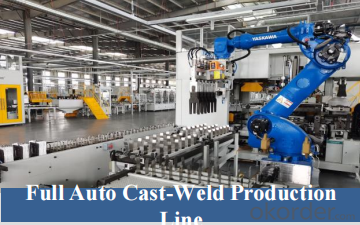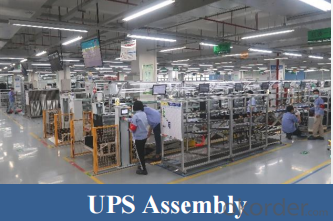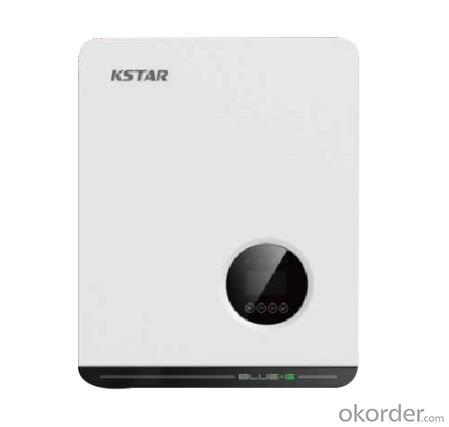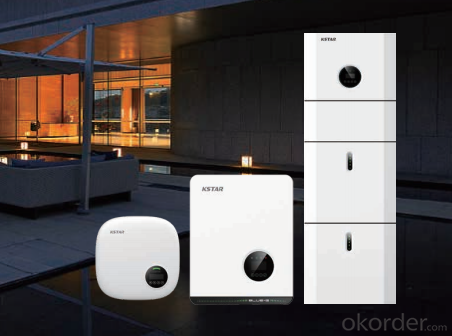Cheap Solar Inverter PV On-Grid String Inverter Blue-3KT ~ Blue-12KT
- Loading Port:
- China main port
- Payment Terms:
- TT OR LC
- Min Order Qty:
- 50 pc
- Supply Capability:
- 15000 pc/month
OKorder Service Pledge
OKorder Financial Service
You Might Also Like
Specification
Product Description:
★Max. PV voltage up to 1100V Type II DC /AC SPD
★DC/AC ratio up to 2 IP66 protection
★High efficiency up to 98.6% Smaller and lighter
★Compatible for big capacity PV panel WiFi / 4G Plug optional
Technical Specifications:
| MODEL | BluE-3KT | BluE-3.6KT | BluE-4KT | BluE-5KT | BluE-6KT | BluE-8KT | BluE-10KT | BluE-12KT |
| Input(DC) | ||||||||
| Max. DC Voltage | 1100V | 1100V | 1100V | 1100V | 1100V | 1100V | 1100V | 1100V |
| Nominal Voltage | 620V | 620V | 620V | 620V | 620V | 620V | 620V | 620V |
| Start Voltage | 180V | 180V | 180V | 180V | 180V | 180V | 180V | 180V |
| MPPT Voltage Range | 140V-1000V | 140V-1000V | 140V-1000V | 140V-1000V | 140V-1000V | 140V-1000V | 140V-1000V | 140V-1000V |
| Number of MPP Tracker | 2 | 2 | 2 | 2 | 2 | 2 | 2 | 2 |
| Strings Per MPP Tracker | 1 | 1 | 1 | 1 | 1 | 1 | 1 | 1 |
| Max. Input Current Per MPPT | 15A | 15A | 15A | 15A | 15A | 15A | 15A | 15A |
| Max. short-circuit Current Per MPPT | 20A | 20A | 20A | 20A | 20A | 20A | 20A | 20A |
| Output(AC) | ||||||||
| Nominal AC Output Power | 3000W | 3600W | 4000W | 5000W | 6000W | 8000W | 10000W | 12000W |
| Max. AC Apparent Power | 3300VA | 3960VA | 4400VA | 5500VA | 6600VA | 8800VA | 11000VA | 13200VA |
| Nominal AC Voltage | 400V 3L+N | |||||||
| AC Grid Frequency Range | 50Hz / 60Hz(±5Hz) | |||||||
| Max. Output Current | 4.8A | 5.8A | 6.4A | 8.0A | 9.6A | 12.8A | 16.0A | 19.2A |
| Power Factor (cosφ) | 0.8 leading to 0.8 lagging | |||||||
| THDi | <3%< td=""> | |||||||
| Efficiency | ||||||||
| Max. Efficiency | 98.40% | 98.40% | 98.40% | 98.40% | 98.40% | 98.60% | 98.60% | 98.60% |
| Euro Efficiency | 97.50% | 97.50% | 97.50% | 97.50% | 97.50% | 98.00% | 98.10% | 98.10% |
| Protection devices | ||||||||
| DC switch | Yes | |||||||
| Anti-islanding Protection | Yes | |||||||
| Output Over Current | Yes | |||||||
| DC Reverse Polarity Protection | Yes | |||||||
| String Fault Detection | Yes | |||||||
| AC/DC Surge Protection | DC: Type II / AC: Type III / Type II Optional | |||||||
| Insulation Detection | Yes | |||||||
| AC Short Circuit Protection | Yes | |||||||
| General Specifications | ||||||||
| Dimensions W x H x D (mm) | 380*438*161 | |||||||
| Weight(kg) | <17 | |||||||
| Operating Temperature Range | –25℃~+60℃ | |||||||
| Cooling Type | Natural Cooling | |||||||
| Max. Operation Altitude | ≤4000m | |||||||
| Max. Operation Humidity | 0-100%(No condensation) | |||||||
| AC Output Terminal Type | Quick Connector | |||||||
| IP Class | IP66 | |||||||
| Topology | Transformer-less | |||||||
| Communication Interface | RS485/WIFI/4G | |||||||
| Display | LCD | |||||||
| Certification & Standard | EN/IEC62109-1/2;IEC/EN61000-6-2;IEC/EN61000-6-4;IEC61683;IEC60068;IEC60529;IEC62116;IEC61727; EN50549-1;AS 4777.2;VDE-AR-N-4105;VDE 0126-1-1;CEI0-21;G98;G99;C10/C11;NB/T32004-2018;GB/T19964-2012 | |||||||
Q:How the output voltage of the PV inverter and the grid-connected voltage are determined
Inverter is the DC power (battery, battery) into alternating current (usually 220V, 50Hz sine wave). It consists of inverter bridge, control logic and filter circuit. Widely used in air conditioning, home theater, electric wheel, power tools, sewing machines, DVD, VCD, computer, TV, washing machine, range hood, refrigerator, video recorders, massage, fan, lighting and so on. In foreign countries
Q:Installation and maintenance of photovoltaic grid - connected inverter
only when the local power sector permission by the professional and technical personnel to complete all the electrical connection before the inverter can be connected.
Q:What is the difference between a PV grid-connected inverter and an off-grid inverter?
Off-grid inverter is equivalent to their own to establish an independent small power grid, mainly to control their own voltage, is a voltage source.
Q:After the PV inverter, how to achieve the same period before the network?
Solar panel simulator: with MPPT function, simulated morning, noon, afternoon, evening, rainy weather, solar panels produced under different conditions in different voltages.
Q:Is the PV inverter a current source or a voltage source?
According to the waveform modulation method can be divided into square wave inverter, stepped wave inverter, sine wave inverter and modular three-phase inverter.
Q:Photovoltaic grid-connected inverter without DC emc how will happen
Solar photovoltaic power generation technology is the use of solar cells, the photovoltaic effect of semiconductor materials, solar radiation can be directly converted into a new type of power generation system, solar energy is a radiant energy, solar power means --- to direct conversion of sunlight Into electricity,
Q:What is the difference between low voltage grid connection and medium voltage grid connection?
For photovoltaic power plants when the power system accidents or disturbances caused by photovoltaic power plant grid voltage drop, in a certain voltage drop range and time interval, the photovoltaic power plant can ensure that non-off-line continuous operation.
Q:Is the grid side of the grid and the inverter?
The grid load side of the grid is the grid. The inverter is an important part of the PV grid-connected system and can not be regarded as an external load. Photovoltaic power generation system is included in both grid and off-grid.
Q:PV grid-connected inverter and independent inverter in the control of what is the difference
The independent inverter in the output voltage phase amplitude of the frequency control is initially set good. Independent inverter, you should refer to off-grid inverter, do not need to consider the grid situation.




- Q: What is the role of anti-islanding protection in a solar inverter?
- The role of anti-islanding protection in a solar inverter is to ensure the safety of utility workers and prevent damage to the electrical grid in the event of a power outage. It detects when the grid goes down and immediately shuts off the solar inverter, preventing it from continuing to generate electricity and potentially sending power back into the grid. This feature is essential to avoid the risk of electricity flowing into the grid, which could pose a danger to technicians working on power lines and disrupt the stability of the electrical system.
- Q: How does a solar inverter handle overloading?
- A solar inverter handles overloading by monitoring the power output from the solar panels and the load demand from the connected appliances. When the load demand exceeds the maximum capacity of the inverter, it automatically adjusts the power output to avoid overloading. Additionally, advanced inverters may have overload protection mechanisms such as short circuit protection, thermal shut down, or automatic shutdown to prevent damage to the system.
- Q: How does the input frequency range affect the performance of a solar inverter?
- The input frequency range of a solar inverter directly affects its performance. A wider input frequency range allows the inverter to accommodate a broader range of input frequencies from the solar panels. This flexibility ensures optimal energy conversion and efficiency, regardless of fluctuations in the grid frequency or varying solar conditions. Conversely, a limited input frequency range may result in reduced performance, as the inverter may struggle to convert the solar panel's output effectively, leading to lower efficiency and potential issues with power output. Therefore, a wider input frequency range positively impacts the overall performance and adaptability of a solar inverter.
- Q: How does a solar inverter handle voltage drops in the electrical wiring?
- A solar inverter typically handles voltage drops in the electrical wiring by continuously monitoring the voltage levels and adjusting its own output accordingly. It is designed to maintain a steady voltage within a specified range, even if there are voltage drops in the wiring.
- Q: How does a solar inverter handle power factor optimization?
- A solar inverter handles power factor optimization by continuously monitoring the power factor of the AC output and adjusting its operation accordingly. It employs various techniques such as reactive power compensation, voltage regulation, and harmonic suppression to ensure that the power factor remains close to unity, maximizing the efficiency of the solar system.
- Q: How does a solar inverter protect against lightning strikes?
- A solar inverter typically has built-in protective measures, such as surge protection devices and grounding systems, that help safeguard against lightning strikes. These protective measures divert the high voltage surge caused by lightning away from the inverter, ensuring its safety and preventing damage to the solar power system.
- Q: How does a solar inverter handle variations in solar panel degradation over time?
- A solar inverter handles variations in solar panel degradation over time by continuously monitoring the performance of the solar panels. It adjusts the power output and voltage levels accordingly to optimize the energy conversion process. This adaptive capability allows the inverter to compensate for any decrease in efficiency caused by degradation, ensuring maximum power generation from the solar panels throughout their lifespan.
- Q: What is the impact of a solar inverter on the overall system cost?
- The overall system cost can be significantly impacted by a solar inverter. An essential component of a solar power system, the solar inverter converts the direct current (DC) generated by solar panels into alternating current (AC) for powering electrical devices or feeding back into the grid. The cost of a solar inverter varies based on its capacity, efficiency, and brand. Generally, more advanced and efficient inverters tend to be pricier. However, investing in a high-quality inverter can lead to long-term savings and improved system performance. Considering the size of the solar power system is important. Inverters have capacity limits, so selecting the right-sized inverter is crucial for optimizing energy production and system efficiency. An undersized inverter can restrict performance, while an oversized one may result in unnecessary additional costs. The quality and reliability of the inverter are also significant factors. A well-built and reliable inverter can minimize maintenance and repair expenses, ensuring a longer lifespan for the solar power system. Furthermore, advanced features like monitoring capabilities and grid integration functionalities can enhance system performance and provide valuable maintenance and troubleshooting data, though they may increase overall system cost. Additionally, the efficiency of a solar inverter can impact the overall system cost. Higher efficiency inverters can convert more DC power into usable AC power, increasing energy production and potentially reducing the number of required solar panels. This can result in cost savings in terms of panel purchase and installation. In conclusion, while the cost of a solar inverter is an important factor in overall system cost, it is crucial to balance it with considerations such as capacity, efficiency, reliability, and additional features. Investing in a properly sized, high-quality inverter can lead to long-term savings, improved system performance, and higher energy production, maximizing the value and benefits of a solar power system.
- Q: What is the role of a communication interface in a solar inverter?
- The role of a communication interface in a solar inverter is to allow for seamless communication between the inverter and other devices or systems, such as a solar monitoring system or a smart grid. It enables the inverter to transmit important data, such as energy production, performance metrics, and fault notifications, to the connected devices or systems. Additionally, it allows for remote monitoring and control of the inverter, enabling users to monitor and optimize the performance of their solar power system.
- Q: Can a solar inverter be used with a hybrid solar power system?
- Yes, a solar inverter can be used with a hybrid solar power system. A hybrid solar power system combines solar energy with other sources such as batteries or the electrical grid. The solar inverter is responsible for converting the direct current (DC) generated by the solar panels into alternating current (AC) that can be used to power household appliances or fed back into the grid. It plays a crucial role in ensuring the compatibility and efficient operation of the hybrid solar power system.
Send your message to us
Cheap Solar Inverter PV On-Grid String Inverter Blue-3KT ~ Blue-12KT
- Loading Port:
- China main port
- Payment Terms:
- TT OR LC
- Min Order Qty:
- 50 pc
- Supply Capability:
- 15000 pc/month
OKorder Service Pledge
OKorder Financial Service
Similar products
Hot products
Hot Searches
Related keywords
































